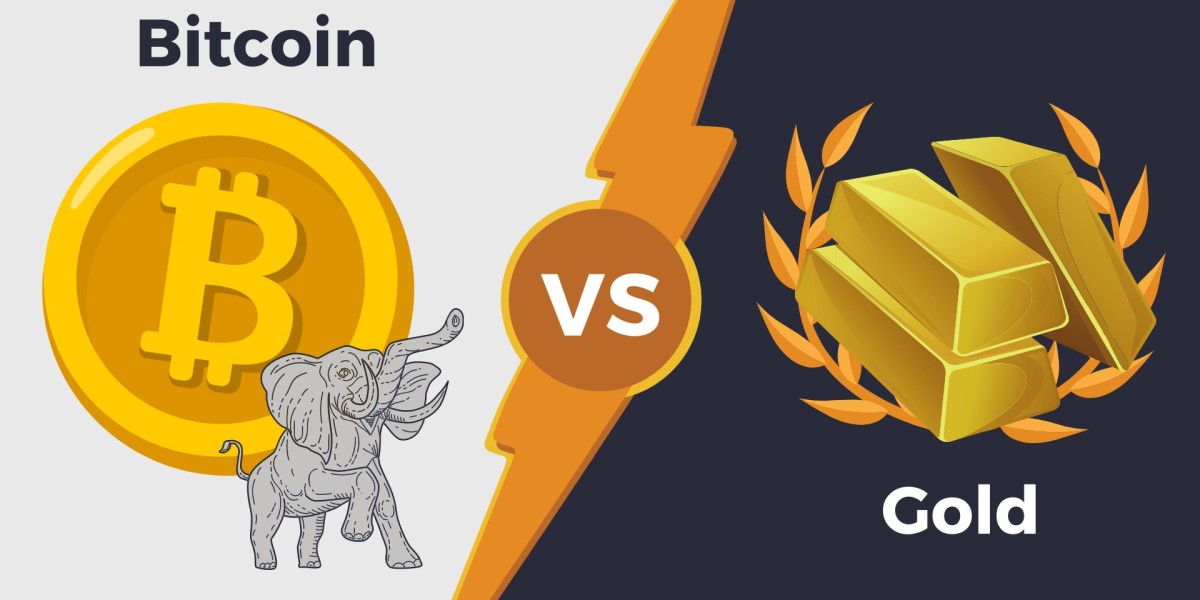For centuries, gold has been a trusted store of value, serving as a safe haven for investors during economic uncertainty. However, in the last decade, Bitcoin has emerged as a digital alternative, earning the nickname “digital gold” due to its limited supply and potential as an inflation hedge.
As we move into 2025, many investors are evaluating whether Bitcoin or gold is the better investment. While both assets offer unique advantages, they differ significantly in liquidity, volatility, regulation, and historical performance. This article provides a comprehensive analysis of Bitcoin vs gold investment, offering insights for beginner and intermediate investors looking to make informed financial decisions.
The Fundamental Differences Between Bitcoin and Gold
Scarcity and Supply Dynamics
One of the main reasons gold has maintained its value over time is its natural scarcity. Gold mining is a slow process, and although new reserves are occasionally discovered, the supply remains relatively limited. This makes gold a finite resource, which helps maintain its purchasing power.
Bitcoin, on the other hand, has a fixed supply of 21 million coins, making it even scarcer than gold. The process of minting new Bitcoin, known as mining, follows a predetermined schedule where the rewards for miners are halved every four years. This event, known as the Bitcoin halving, reduces the rate at which new BTC enters circulation. The next halving is set for April 2024, which could drive Bitcoin’s price higher in 2025 due to increased scarcity.
Because of this predictable and transparent supply mechanism, Bitcoin offers more certainty about its scarcity than gold. While gold’s supply may increase with new mining efforts, Bitcoin’s supply is mathematically capped, making it an attractive long-term asset for investors.
Liquidity and Accessibility
Gold has been traded for centuries, and investors can access it through various forms such as physical bullion, ETFs (exchange-traded funds), and futures contracts. However, buying and selling physical gold requires secure storage and incurs transaction fees. Investors who prefer to trade gold ETFs or futures may face restrictions depending on market hours and regulatory requirements.
Bitcoin, in contrast, offers unparalleled liquidity due to its 24/7 trading availability on global exchanges. Investors can buy, sell, or transfer Bitcoin instantly with low transaction costs compared to handling physical gold.
Additionally, Bitcoin can be stored digitally in wallets, making it more accessible than physical gold, which requires vaults or bank storage. Investors can track BTC/USDT trading pairs in real time, allowing them to react swiftly to market changes.
This ease of access gives Bitcoin a significant advantage over gold for traders looking for instant transactions and global accessibility.
Volatility and Risk: Bitcoin vs. Gold as a Store of Value
Gold’s Stability vs. Bitcoin’s Volatility
Gold has a long history of stability, making it a preferred safe-haven asset during economic downturns. While its price fluctuates, gold generally retains its purchasing power over time. For instance, during financial crises, investors flock to gold as a hedge against inflation and currency devaluation.
Bitcoin, on the other hand, is known for its extreme price volatility. The cryptocurrency has experienced massive bull runs, such as its surge to nearly $69,000 in 2021, followed by sharp corrections.
Despite its volatility, Bitcoin has demonstrated high return potential, outperforming gold in many investment cycles. The asset’s price movements are influenced by factors such as institutional adoption, regulatory developments, and macroeconomic conditions.
For conservative investors, gold provides stability and lower risk, whereas Bitcoin presents a high-risk, high-reward opportunity.
Inflation Hedge: Bitcoin vs Gold
Historically, gold has been a trusted hedge against inflation. When fiat currencies lose value due to excessive money printing or economic downturns, gold typically appreciates. For example, during the 1970s and 2008 financial crises, gold prices surged as investors sought a safe store of value.
Bitcoin is increasingly being considered an alternative inflation hedge. Its decentralized nature and fixed supply make it resistant to government monetary policies.
In recent years, Bitcoin has gained popularity as a hedge against inflation, especially in countries facing currency devaluation. However, due to its volatility, some investors remain skeptical about its long-term stability as a store of value.
While gold has proven itself as an inflation hedge for centuries, Bitcoin is an emerging competitor with high growth potential. The decision depends on an investor’s risk tolerance and belief in the long-term adoption of digital assets.
Investment Strategies: Choosing Between Bitcoin and Gold
Risk Tolerance and Investment Goals
Investors should consider their risk tolerance when deciding between Bitcoin and gold.
Gold is ideal for conservative investors who prioritize stability and long-term security. It offers lower risk but moderate returns over time.
Bitcoin suits risk-tolerant investors looking for high-growth opportunities. Despite its volatility, Bitcoin has historically delivered significant returns over longer time frames.
For example, if an investor purchased 1 Bitcoin in 2015 for $300, their investment would be worth thousands of times more today. Meanwhile, gold’s price increased modestly during the same period.
Portfolio Diversification: Why Not Both?
Many investors are choosing to diversify their portfolios by holding both gold and Bitcoin. This approach allows them to balance stability and growth potential.
Gold provides a safety net during economic downturns.
Bitcoin offers higher returns and exposure to the rapidly growing digital asset market.
Financial analysts suggest that allocating 5-10% of a portfolio to Bitcoin, along with traditional assets like gold, can create a well-balanced investment strategy.
Market Outlook for Bitcoin and Gold in 2025
Bitcoin’s Future Growth and Institutional Adoption
Bitcoin is rapidly gaining traction among institutional investors, hedge funds, and corporations. Companies like Tesla, MicroStrategy, and Square have already invested billions into Bitcoin.
Additionally, the development of Bitcoin ETFs allows more traditional investors to gain exposure to Bitcoin without directly owning it. This institutional interest may drive Bitcoin’s price higher in 2025.
Moreover, the 2024 Bitcoin halving is expected to further reduce supply, which historically has led to significant price increases.
Gold’s Role in an Uncertain Economy
Gold continues to be a reliable investment during financial crises. With growing concerns over global inflation, rising interest rates, and geopolitical tensions, demand for gold is expected to remain strong in 2025.
Central banks continue to stockpile gold, reinforcing its role as a long-term store of value.
Conclusion: Bitcoin or Gold – Which is the Better Investment in 2025?
Both Bitcoin and gold offer unique advantages depending on an investor’s financial goals and risk tolerance.
Gold remains the go-to safe-haven asset, offering stability and protection during economic downturns.
Bitcoin, while volatile, has demonstrated high return potential and increasing adoption among institutions.
For those who want security and long-term wealth preservation, gold remains the best choice. However, investors looking for growth, innovation, and digital asset exposure should consider adding Bitcoin to their portfolios.
A balanced investment approach that includes both Bitcoin and gold can help mitigate risk while taking advantage of future opportunities.
As we move into 2025, staying informed about market trends, regulations, and economic shifts will be crucial for making the right investment decision.
Would you invest in Bitcoin, gold, or both? Let us know your thoughts!










